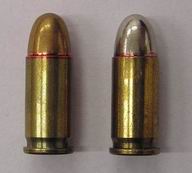
A semi-automatic pistol is a handgun that automatically ejects and loads cartridges in its chamber after every shot fired. Only one round of ammunition is fired each time the trigger is pulled, as the pistol's fire control group disconnects the trigger mechanism from the firing pin/striker until the trigger has been released and reset.

The .40 S&W (10.2x21mm) is a rimless pistol cartridge developed jointly by American firearms manufacturers Smith & Wesson and Winchester in 1990. The .40 S&W was developed as a law enforcement cartridge designed to duplicate performance of the Federal Bureau of Investigation's (FBI) reduced-velocity 10mm Auto cartridge which could be retrofitted into medium-frame semi-automatic handguns. It uses 0.40-inch (10 mm) diameter bullets ranging in weight from 105 to 200 grains.

The .380 ACP (9×17mm) is a rimless, straight-walled pistol cartridge developed by firearms designer John Moses Browning. The cartridge headspaces on the mouth of the case. It was introduced in 1908 by Colt, for use in its new Colt Model 1908 pocket hammerless semi-automatic, and has been a popular self-defense cartridge ever since, seeing wide use in numerous handguns. Other names for .380 ACP include .380 Auto, 9×17mm, 9mm Browning, 9mm Corto, 9mm Kurz, 9mm Short, and 9mm Browning Court. It should not be confused with .38 ACP. The .380 ACP does not strictly conform to cartridge naming conventions, named after the diameter of the bullet, as the actual bullet diameter of the .380 ACP is .355 inches.
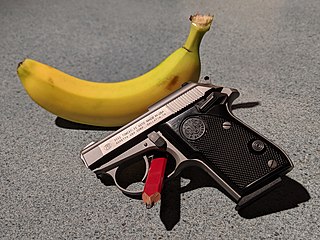
The Beretta 3032 Tomcat and Beretta 3032 Tomcat Inox are semi-automatic pocket pistols designed and manufactured by Beretta. They are chambered in .32 ACP and are small pistols, designed for concealed-carry and use as backup weapons. The Beretta 3032 Tomcat builds on a long line of small and compact pocket pistols for self defense manufactured by Beretta. The allure and popularity is commonly attributed to the loading procedure, which does not require the user to "rack" the slide to chamber a round, but rather place a round in the tip-up barrel before the magazine is inserted. This is especially popular for those with weaker or smaller hands.

The Walther PP series pistols are blowback-operated semi-automatic pistols, developed by the German arms manufacturer Carl Walther GmbH Sportwaffen.

The Thunder 380 is a lightweight, relatively small semi-automatic pistol series chambered in the .380 ACP caliber made by Argentine firearms manufacturer Bersa, S.A.

The Škorpion vz. 61 is a Czechoslovak machine pistol developed in 1959 by Miroslav Rybář (1924–1970) and produced under the official designation Samopal vzor 61 by the Česká zbrojovka arms factory in Uherský Brod from 1963 to 1979. The standard version uses .32 ACP ammunition.

The HK4 is a pocket pistol, first introduced by Heckler & Koch in 1967. Government agencies received 12,000 pistols in the .32 ACP caliber with the designation P11 and were serial numbered 40001 to 52400. It was distinctive for allowing shooters to swap barrels chambered for different cartridges without tools and for having a durable but light hard-anodized aluminum-alloy frame.

In American English, a pocket pistol is any small, pocket-sized semi-automatic pistol, and is suitable for concealed carry in a pocket or similar space.

Locked breech is the design of a breech-reloading firearm's action. This is important in understanding how a self-reloading firearm works. In the simplest terms, the locked breech is one way to slow down the opening of the breech of a self-reloading firearm when fired. The source of power for the movement is recoil.
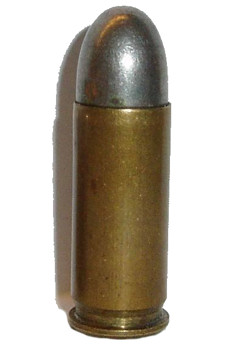
The .38 ACP, also known as the .38 Auto or 9x23mmSR, is a semi-rimmed pistol cartridge that was introduced at the turn of the 20th century for the John Browning-designed Colt M1900. It was first used in Colt's Model 1897 prototype, which he did not produce. The metric designation for the round is 9×23mm SR (semi-rimmed), which is not to be confused with other 9×23mm cartridges.

The FÉG PA-63 is a semi-automatic pistol designed and manufactured by the FÉGARMY Arms Factory of Hungary.

The Colt Model 1900 is a short-recoil operated "self-loading", or semi-automatic .38 caliber handgun introduced by Colt's Manufacturing Company at the turn of the 20th century. The M1900 was the first firearm to be chambered in .38 ACP and was the first handgun to utilize short-recoil operation.
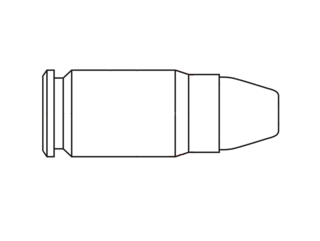
The .32 NAA is a cartridge/firearm 'system' designed and developed by the partnership of North American Arms and Corbon Ammunition. The cartridge is a .380 ACP case necked-down to hold a .32 caliber bullet with the goal of improved ballistic performance over the .32 ACP.
The FEG AP9 is a semi-automatic pistol designed and manufactured by the FÉG company of Hungary.

A handgun is a firearm designed to be usable with only one hand. It is distinguished from a long gun which needs to be held by both hands and braced against the shoulder. Handguns have shorter effective ranges compared to long guns, and are much harder to shoot accurately. While most early handguns are single-shot pistols, the two most common types of handguns used in modern times are revolvers and semi-automatic pistols, although other handguns such as derringers and machine pistols also see infrequent usage.
Bersa is an Argentine arms manufacturer, located in the city of Ramos Mejía in Argentina.
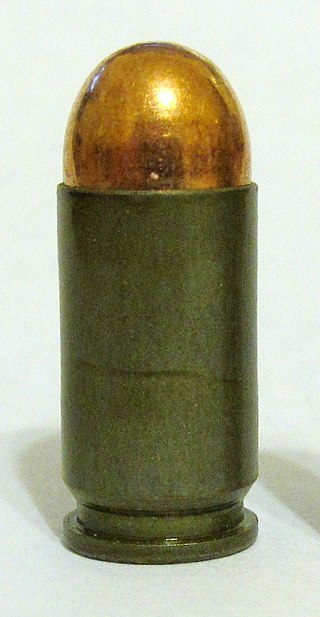
The 9×18mm Makarov is a Soviet pistol and submachine gun cartridge. During the latter half of the 20th century, it was a standard military pistol cartridge of the Soviet Union and the Eastern Bloc, analogous to the 9×19mm Parabellum in NATO and Western Bloc military use.

The 9×18mm Ultra is a German pistol cartridge. It was originally developed in 1936 for use by the Luftwaffe, but was not adopted at that time.
